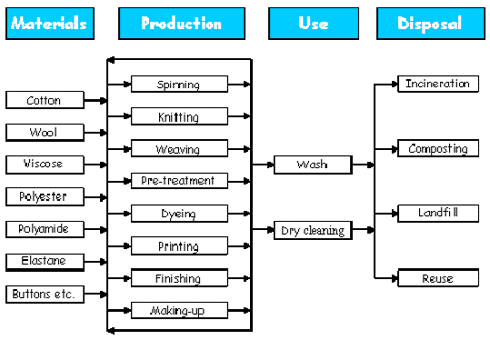EDIPTEX - Environmental assessment of textiles
5 Structure of the EDIPTEX database
The overall structure of the database follows the structure of the EDIP unit process database. The structure can be illustrated using the process tree below for the four lifecycle phases at level I: Materials, Production, Use and Disposal; and level II for the processes of the different phases.

Figure 5.1 Structure and levels in the EDIPTEX database
For each category at level II, there may be further details at levels III, IV, V and so on.
The processes cover production of materials cotton, viscose, polyester, polyamide (type PA 6.6), polypropylene and acrylic. In total, these six fibre types cover more than 90 per cent of the EU market for garment textiles. The six fibres are also dominant for many other product groups. Data for elastane were not available, but a process has been established for elastane where data for polyurethane flexible foam are used (elastane consists of 85 per cent polyurethane). Data for standard components like zippers and buttons, i.e. metals and plastic materials, are well supported by existing data in the EDIP database.
The production phase, from yarn manufacturing to making-up, is the phase of the textiles' the lifecycle where the Danish textiles sector is active, and the database is therefore very differentiated and detailed for this phase. Unit processes established in the project's database are verified and representative for the sector. Sixteen enterprises from all links in the production chain have been involved. There have been one or two representative enterprises from each of the areas spinning, weaving, knitting, dyeing, printing, finishing and making-up. No direct measurements of e.g. energy consumption or wastewater analyses have been made for the project. It has been possible to document energy consumption sufficiently by calculating energy consumption for heating and drying and by taking readings of the individual machines' energy consumption on their rating plates. The composition of the wastewater has been documented by consulting the lists of ingredients used in combination with the available knowledge on the fate of the individual chemicals in production and wastewater treatment plants. Verification of these data was carried out by means of energy and mass balances for the enterprise's total energy consumption as well as existing wastewater analyses.
The unit processes established in the database for the use phase are standard maintenance processes where resource consumption and environmental impacts have been calculated and verified by the Danish Technological Institute, Textile.
Examples of environmental assessments prepared on the basis of the project's database have identified the lifetime of the textiles as a crucial factor for the environmental assessment. The Danish Technological Institute, Textile has defined realistic lifetimes for the products on the basis of the centre's extensive knowledge on textiles, fabrics and materials, and in cooperation with the participating enterprises.
Disposal data in the project's database have been calculated in accordance with the current practice for lifecycle assessment.
Emissions during incineration have been calculated on the basis of the chemical composition of the fibres.
As the textiles sector uses a large number of different chemicals in production - both single chemicals and composite products - many assumptions have been made during the course of the project. From the beginning of the project, it was decided not to include the production of any of the chemicals in EDIPTEX. Moreover, occupational health and safety has not been included.
Data for human toxicity and ecotoxicity for a total of 50 different chemicals have been included. To the extent necessary, the names of the chemicals have been made anonymous and appear under general names. It is very difficult, if not impossible, to obtain sufficient information for a lifecycle assessment from chemicals suppliers and producers. The project has assessed chemicals at a theoretical level in accordance with the methods recognised in the EDIP method.
A more detailed account of the principles for assessments of chemicals can be found in annex 7: "Management of chemicals in EDIPTEX".
Version 1.0 July 2007, © Danish Environmental Protection Agency